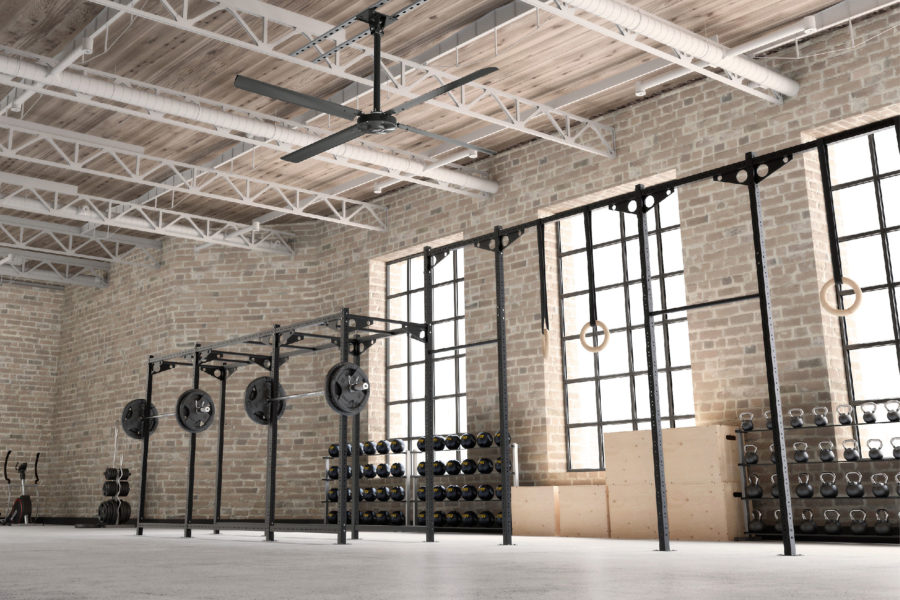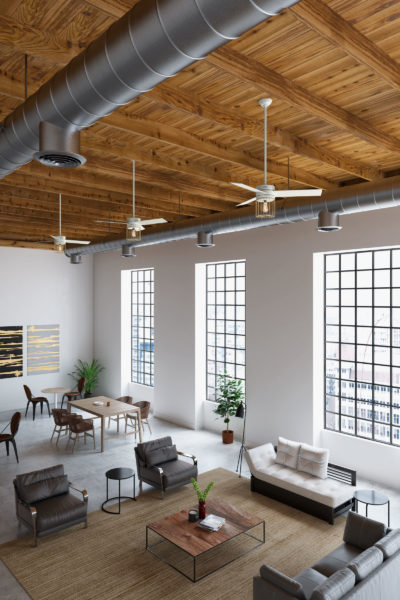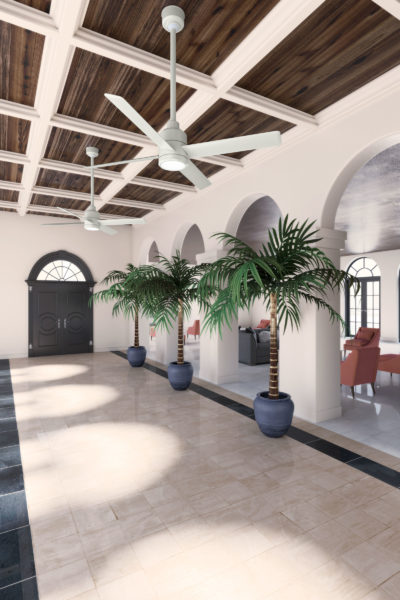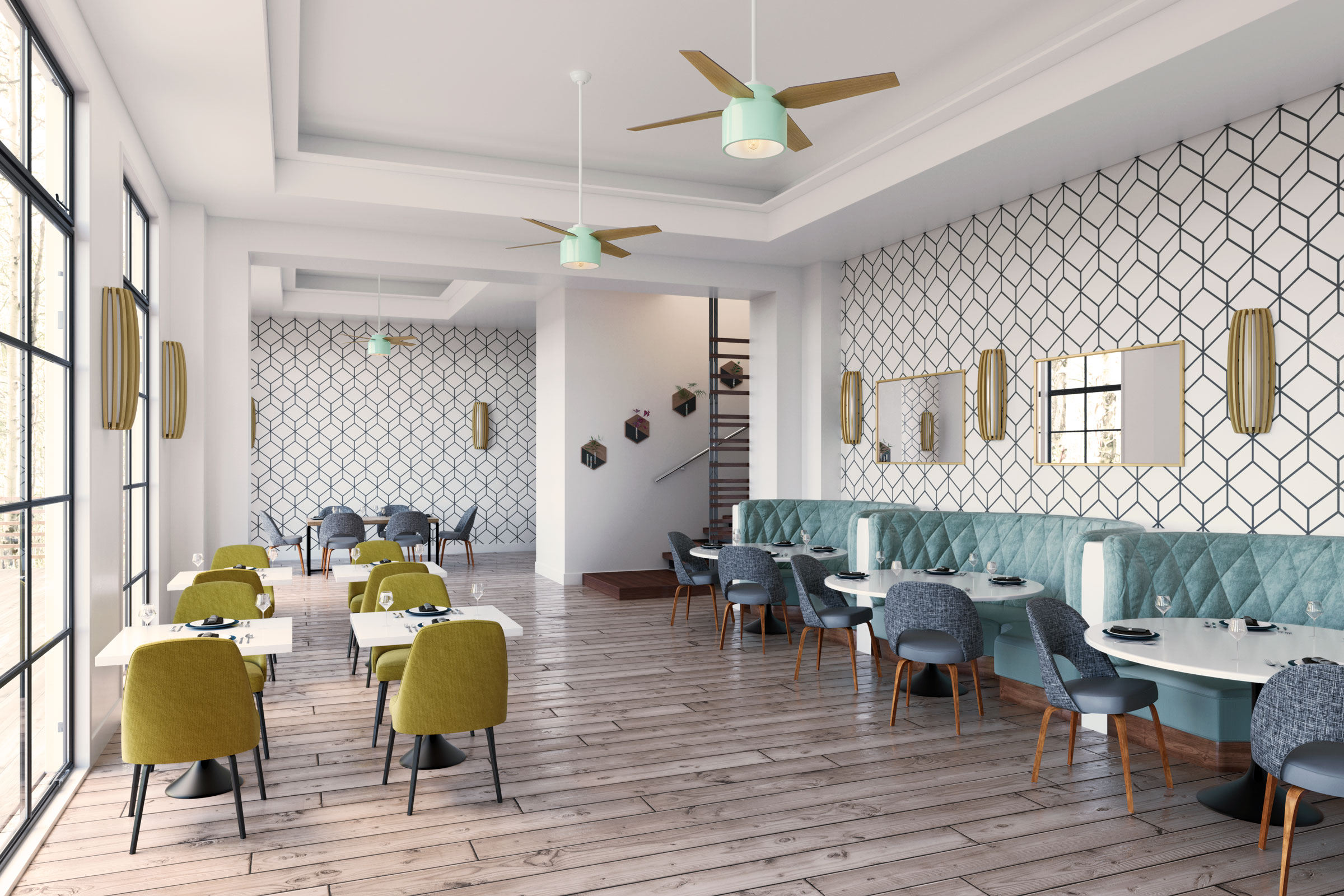Story at a glance:
- HVLS fans can increase worker productivity by improving workplace comfort and reducing mistakes.
- HVLS fans also reduce energy use, providing thermal comfort with less dependence on HVAC systems.
- Hunter Industrial fans help alleviate “sick building syndrome” by mixing stagnant air and lowering the concentration of harmful particles.
- Commercial ceiling fans are the most sustainable tools for improving indoor air quality in public spaces.
Over the past few years, architects, developers, and facility managers have increasingly been focused on the health and well-being of the people who will occupy the spaces they design and manage. That is in part due to the effects of the pandemic on our workplaces, whether that’s an office building, a warehouse, or a restaurant.
“This attention to employee health and comfort really begins with air quality,” says Drew Placido, director of commercial channel at Hunter Industrial, a division of Hunter Fan. “And in order to improve indoor air quality and air circulation, you need to consider how you can incorporate ceiling fans into your space.”
Hunter Fan has evolved dramatically since John Hunter first invented the ceiling fan back in 1886. The company launched its commercial unit, Hunter Industrial, in 2016 as the demand for high-volume, low-speed (HVLS) fans continued to rise. Even before the pandemic, facility managers were beginning to appreciate the fact that the quality of air in a workspace could have an enormous impact on the health, well-being—and therefore the productivity—of the people who occupied it.
“In launching Hunter Industrial, we were really responding to the increased awareness of the importance of indoor air quality, and our goal is to make these workplace environments a better place for people in general,” Placido says.
In the past few years Hunter has developed a number of product lines that provide commercial and industrial customers with a wide variety of choices in size, performance, and design. And with the warehouse sector booming and office employees returning to the workplace, some analysts believe the true potential of the commercial ceiling fan market is three times its current size.
Placido sat down with gb&d to discuss the importance of improving indoor air quality, as well as the sustainability benefits of HVLS fans.

Photo courtesy of Hunter Fan
Tell us about the importance of indoor air quality in commercial and industrial spaces. How does this impact health and well-being?
Indoor air quality is critical to the health, comfort, and well-being of those who inhabit the space. There are countless studies out there demonstrating this, but one of the most substantial is from NASA, which showed that work area temperature is key to worker productivity and therefore business success in commercial facilities.
We see that worker behavior changes as temperature changes, and that employee activity and error rate correlates with a rise in temperature. NASA found that in a commercial environment, when temperatures rise 5 degrees, so from 80 to 85 degrees, worker output drops by 18% and the accuracy of their work drops by 40%. HVLS fans are the most efficient and effective way to cool these large spaces.
In today’s day and age, everyone understands that air movement and ventilation is a necessity. And it isn’t just big warehouse spaces that we need to think about when it comes to air quality—facility managers for office buildings need to consider how air flows through their space as well.
Contemporary office buildings are usually made from glass and feature higher ceilings because we like to have more space, but both of these trap more heat. Without the proper destratification tools—simply to exchange the air in a peaceful manner—we’re not going to have healthy, comfortable environments. Improving indoor air quality is critical to the productivity and the comfort people feel in these environments.

Hunter Fan HVLS fans fit in beautifully in this modern apartment complex design. Photo courtesy of Hunter Fan
How does improved air circulation help alleviate sick building syndrome?
I think the pandemic has really raised awareness around the issue of sick building syndrome, which is when people who occupy a building experience health symptoms related to the quality of air within that space. We firmly believe business owners should remain diligent in providing the healthiest and most comfortable workplace they can, and fans are by far the most efficient way of doing that.
Specifically, HVLS fans are a key component of any indoor ventilation strategy that reduces stratification by mixing otherwise stagnant air. Think about it: Air that is stagnant and not moving is no different than water that is stagnant, and that’s where pathogens concentrate. And we can’t just focus on biological microbes, either.
Volatile organic compounds (VOCs) permeate most office and industrial spaces. VOCs are invisible chemical gasses that are emitted from common workplace items like printing machines, air fresheners and disinfectants, and even paint and wood preservatives. Over time the daily inhalation of VOCs can cause headaches, fatigue, and eventually organ damage. It’s incredibly important to have good air circulation and ventilation in our work environments, to break down and eliminate these potential problems.
How is Hunter Industrial addressing these concerns around air quality and employee health and comfort?
We truly have to think about how those employees are experiencing the space they work in. When we talk about employee comfort, the difference humans will feel in a space with a fan versus a space without one is about an 8- to 10-degree ambient difference. That’s not the actual temperature difference, but the perceived difference—which is what matters most.
What’s amazing is, in a large industrial space, if you take the temperature at the floor and then at the ceiling, you could have a 30-degree difference. And a thermostat is only reading at one level, which is why moving that air and destratifying it is so critically important to human comfort.
Now, the flip side of improving air circulation is that people generally don’t want to work in or visit a really windy environment. That’s why our commercial Trak Fan’s performance is measured in cubic feet of air moved per minute, which is essentially how we measure wind flow. A lot of times people will talk about velocity, which is how fast the fan blades spin, but no one wants papers blowing around or wind irritating their eyes. So we focus on exchanging air in a manner that doesn’t create gusts of air but rather feels cooler. Velocity isn’t the blades spinning, but rather the speed the air is traveling at a given distance away from the fan. You can correlate that air velocity down to the ambient difference. Think “wind chill factor.”
So for example, we designed our Titan and Eco HVLS fans, which feature aeronautically designed blades up to 24 feet in diameter, to move at a slow and steady pace, but they can circulate about 30,000 to 40,000 cubic feet per minute. For a big space like a warehouse or a gym, just a few of these fans is going to have a huge effect.

Photo courtesy of Hunter Fan
How are HVLS fans an environmentally friendly solution to these problems?
Industrial ceiling fans have one of the lowest costs of ownership throughout the entire HVAC category. We are also very low in consumed energy, the amount needed to operate these fans. Now, this is true of the industry as a whole, but at Hunter we take sustainability a step further as part of our conscientious environmental mission.
To this end we developed direct drive motors for our HVLS fans, which require less electricity to move air than the standard gearbox motors. They also do not generate heat like traditional AC motors, nor do they drop in efficiency when the speed is slower. Not only does this dramatically lower the amount of energy that is burned, but also offers up to 30% yearly savings on heating costs. Noise pollution can be a distraction. Our direct drive motors provide a more comfortable atmosphere with a lower decibel rating than a gearbox motor.
Cooling provided by HVLS fans in conjunction with a traditional HVAC system is far more efficient: Air movement created by HVLS fans cause people to feel 8 to 12 degrees cooler. Thermostats can be adjusted to reducing AC dependence.
We want to be good environmental stewards in other ways as well. That’s why Hunter uses 100% recycled content in all of our packaging material.

HVLS fans move air quickly and quietly to make for a comfortable resort lobby. Photo courtesy of Hunter Fan
What new technologies is Hunter Industrial developing to offer a whole-space air movement solution?
We are currently developing new control solutions that will be able to control commercial, industrial, and residential fans on the same system so customers can enjoy our full product offering. The goal is for us to be like Switzerland and to be able to play nice with every product within the overall system. For example, we want to make sure we’re plugged into the fire suppression system, so if there’s a fire alarm the fan stops immediately and doesn’t spread the fire further. This is a requirement via NFPA 13.
And with our SIMPLEconnect® fans, Hunter’s Wi-Fi ceiling fans are easy to install and control. Customers can use their smartphones or smart home applications like Apple HomeKit, Amazon Alexa, or Google Assistant to control their air circulation devices. This can further increase energy efficiency by syncing the fans with your thermostat, keeping the space cool and your energy bills low.





